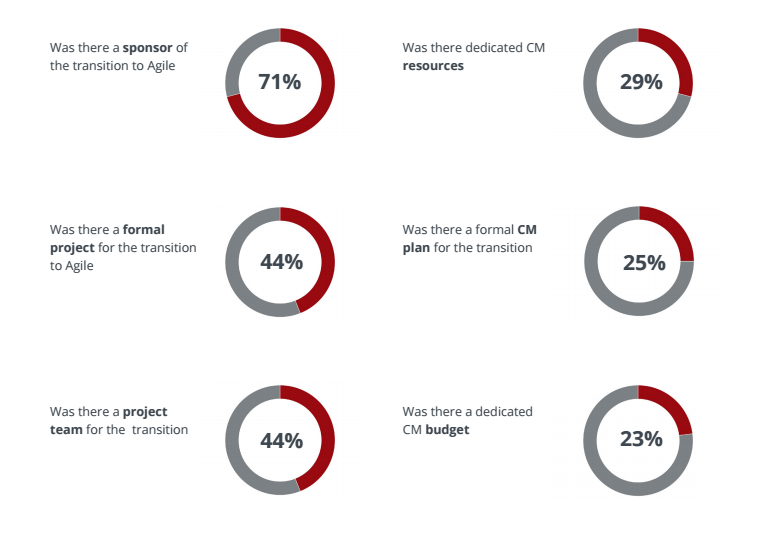Effectively Managing the Move to Agile

4 Mins
Updated: August 12, 2022
Published: September 20, 2017

To respond to recent changes, organizations are deploying Agile methods and mindsets using iterative development to increase alignment with client needs, increase speed to value, and reduce risk over the project lifecycle. However, moving from traditional waterfall approaches to Agile approaches is a change in and of itself—one that must be intentionally and effectively managed.
The transition to Agile can be plagued with obstacles. It takes more than a declaration or hiring a few Agile coaches. Systemically adopting Agile throughout an organization takes structure and intent.
Transitioning to Agile Methods
As more organizations tackle the challenge of bringing an Agile mindset and culture to life alongside the deployment of Agile methods and tools, change management will play a critical role. Prosci research identifies insights and guidance to help organizations that have embarked on this transformation in Change Management and Agile: The intersection of the people side of change and Agile development processes. One part of the report explores how to effectively manage the people side of change when moving from waterfall TO Agile—the systemic introduction of Agile as an approach sometimes called the “Agile Transformation.” The other part of the report explores how to most effectively adapt and adjust the practice of change management IN a project using Agile.
Read on to explore highlights from the research on effectively managing the people side of change and driving adoption when moving from waterfall TO Agile.

Motivation for moving to agile
“Acknowledgment that something had to change. Projects are taking too long (from end to end), deliverables are not meeting the customer's expectations and the relationship (business vs IT) is strained.”
Study participants identified three key motivations for systemically adopting Agile as an enterprise approach:
- Increasing the speed of delivery
- Ensuring client satisfaction
- Optimizing efficiency and flexibility
The motivation for adopting Agile systemically plays a key role in building commitment and adoption to Agile throughout the organization. The motivation must be shared broadly and not with a select few. Leaders need to answer key questions related to "Why?" "Why now?" and "What if we don’t?" for impacted employees. Setting the expectation that each employee will have a new role in relation to change is critical, and sharing the motivation for Agile plays a key role.
“The main objective is to ensure we build the right solution with the right architecture and in line with the agreed and validated business requirements. To succeed in this we need to understand the business needs in detail, which means the business is highly involved from the start and throughout the entire development lifecycle. By having frequent validations we capture feedback more frequent[ly] [than] before.”
Structuring the agile transformation
Implementing a new system for change—whether Agile, Lean Six Sigma, total quality, portfolio management, or change management—takes effort and energy. Prosci asked study participants questions related to sponsorship, as well as the technical side and the people side of structuring the Agile Transformation.

Among the research respondents, 71% reported having a sponsor for the transition to Agile. The most common sponsors were at the vice president, executive vice president, chief information officer, or director level.
Fewer than half (44%) of the respondents reported having a formal project for the transition to Agile, and the same percentage had a dedicated project team.
The numbers drop off significantly when it comes to having a change management structure to support the move to Agile. Only 29% reported having dedicated change management resources. Just 25% reported having a dedicated change management plan. And 23% reported having a dedicated change management budget.
For Agile transformations to be successful, they need guidance and direction from senior leaders, a solution to deploy the technical side of adopting Agile, and a solution to support individual transitions on the people side.
Greatest contributors to successful transformation to agile
“Having a strong disruptive leader who has no doubt the transition will work and is 100% committed to the transition.”
Study participants identified four top contributors to successful transformation:
- Ensuring strong executive sponsorship
- Communicating effectively
- Training on Agile
- Ensuring Agile experts were involved in the effort
Senior leaders must support Agile itself. Senior leaders support the transition by demonstrating Agile values, speaking to the “why” behind using Agile, and eliminating ambiguity. They build Awareness of the need for change. Communication, training, and access to experts support the Desire, Knowledge and Ability of operating in an Agile environment.
Greatest obstacles to success when transforming to agile
“Project team lack of knowledge - the approach was new to everyone and made seasoned waterfall practitioners nervous about their own capabilities.”
Resistance was the biggest obstacle identified by participants, along with:
- Resistance to the Agile approach and not seeing the value
- Maintenance of traditional waterfall approaches
- Lack of strong executive sponsors
- Fear of failure
Resistance to Agile was the biggest obstacle identified, but it can be addressed by leveraging change management tactics. Preventative resistance management would focus on explaining the value of Agile early on. Proactive resistance management identifies expected points of resistance and addresses them before they have consequences. Reactive resistance management puts in place mechanisms for identifying and reacting to resistance when it happens. The change management practices related to resistance management directly address this obstacle.

What to do differently next time
“Have experienced Scrum Masters as Agile champions to show/lead. To specifically train, coach, mentor and facilitate the process.”
“Define and set expectations up-front. Define as a group what Agile is and isn't because I believe people have different definitions. Pick an Agile flavor that works best and stick with it.”
The top three responses to “What would you do differently next time?” were all related to the people side of the Agile transformation:
- Create a change management plan
- Create buy-in from impacted groups
- Deliver more coaching on Agile
By more effectively preparing, equipping and supporting people through their own journeys related to Agile, you will improve the adoption of Agile and realize the benefits of its systematic deployment.
Other report findings
In addition to more details on top contributors and top obstacles for Agile transformation, the research also addresses:
- Increasing engagement in Agile across the organization
- Managing resistance to Agile
- Assessing the duration of your Agile transformation
- Sustaining and cementing the change to Agile
Moving to Agile Change Management
Embarking on the journey of adopting Agile as a standard approach requires structure and intent. As Calvin Coolidge observed, “Those who trust to chance must abide by the results of chance.” Prosci’s research provides concrete insights and direction for the practitioners and leaders who want to extend beyond applying Agile on a particular initiative and truly facilitate the cultural and mindset shifts required to internalize and embed Agile.

